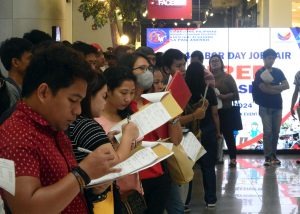BANANA exporters have concentrated their efforts in ensuring that the Japanese market will continue to be its main buyer after the performance of the two other big markets, China and Korea, has declined since about five years ago.
This was confirmed by officials of the Pilipino Banana Growers and Exporters Association, the group of the 18 biggest banana companies in the country that include the biggest international brands.
Early this year, the association, with the help of the national government agency, through the office of the Jose Laquitan, Philippine Embassy in Japan agriculture attache, launched a public relations and government relations campaign to strengthen the hold of the Philippine banana in the Japanese market.
Alberto P. Bacani, president of the association, said the goal of the action “was to bring to the attention of Japanese consumers, the Japanese government as well as trade organizations like the supermarket organizations in Japan about the plight of the Philippine banana industry.”
“As you know, since last year, a lot of farm inputs required in banana growing really (sic) went up,” said Bacana in a press briefing this week here, citing as an example the fertilizer prices that have “almost doubled.”
Because of the rise in operational costs, which have been aggravated by the unabated increase in price increases of petroleum products, Bacani said that their goal was for the Japanese market to support the Philippine banana industry considering that the local industry is about 75% of the total Japanese banana market.
As an initial result of the campaign, Bacani added, there has been at least an increase in the retail of about 30 yen a kilogram as the average price increased from 248 yen a kilogram to 278 yen a kilogram compared with about five years ago.
If translated to the per box of 13.5 kilograms could amount to about $2.50 in price uptick.
However, the increase was somehow balanced by the devaluation of the Japanese currency, said Bacani, also the president of Unifrutti Philippines.
“I would say it (increase in prices as a result of the campaign) was a very good result in such a short time and we hope to keep the momentum,” he pointed out, adding that the expectation was that the increase started kicking in last month considering that the Japanese fiscal year only starts in April.
In China, in the last five years, “there has been a huge reduction of the Philippine market share,” said Bacani, citing that before, about 80% of those being imported by the Chinese buyers was from the Philippines, but this has gone down to just 36%.
This is caused by the move of Chinese investors to set up farms in Laos, Cambodia and Vietnam because of their proximity to these countries. Cambodia and Vietnam supply 51% of the China market banana requirement.
“For Korea, not as bad (but if) looked 10 years ago, 95% of bananas imported to Korea were from the Philippines,” he said, adding that the volume has gone down to 70%.
The rest of the volume that goes into the Korean market comes from South American producers that “enjoy preferential tariff,” while the Philippines is imposed about 30% in tariff.
“That is why we are really pushing with this Japan because we don’t want to suffer (what we suffer in Korea,” Bacani said of the campaign as well as the move to push Japan to bring down to zero tariff from a high of 18% during winter time, or at a low of eight percent during summer.
In the Middle East, the Philippine banana has been considered more expensive compared with those from South American countries because the bananas that they failed to sell in their primary markets in Europe and USA are brought to these gulf countries at a discounted price just so they could recover the cost.
Another problem of the industry in relation to export is that production projection, on an annual basis, would only result in about 140 million boxes this year, compared with about 160 million on average in the last two years.
Of the total production of the country, about 40% goes to Japan, which is considered the top market, followed by China which has about 25%.
The reduction in the production can be blamed on the reduction of the production area, which was about 85,000 hectares at its height a decade ago, and has been down to about 50,000.
The reduction in production area started when typhoon Pablo, considered among the strongest to hit the Southern Mindanao area, bulldozed one of the biggest banana production areas in Davao del Norte and Davao de Oro, then Compostela Valley, in November 2012.
Another reason for the reduction of the production area is the prevalence of Fusarium wilt, also known as Panama disease because of its origin in the 1920s, which has rendered some farms useless. A big company abandoned its Davao de Oro farm of about 100 hectares due to the infestation.
“There are a lot of abandoned farms,” said Bacani as about half of the lost production area is in the Davao Region, considered the main production area of the Cavendish area.
He said initiative to expand has been limited to replace the lost hectarage as companies, instead of investing in the country, decided to invest in other countries because of the high cost of production as well as the proximity to big buyers.
He pointed out that the biggest losers in the battle against Fusarium wilt are the small banana growers because of their limited capability in dealing with the problem, among them the need to look for new areas of production.


